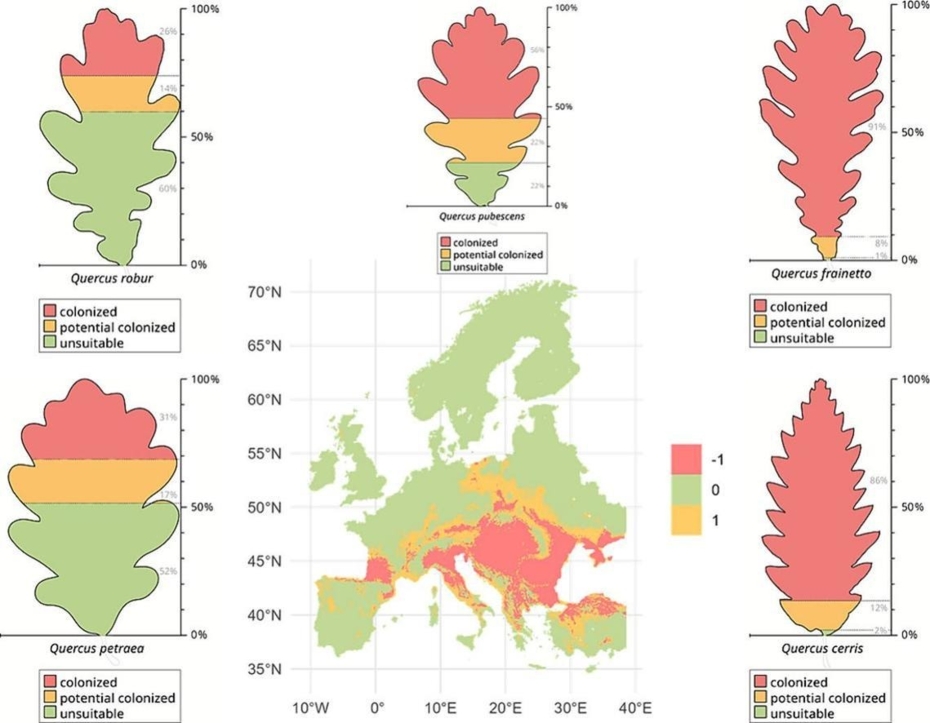
2.7 Risks and resilience

Risk assessment is a foundational step in designing effective forest restoration plans, especially in the face of accelerating climate change. The ability to anticipate and manage future risks is essential to ensure the long-term success of restored areas and their capacity to deliver ecological, economic, and social benefits. This process involves evaluating not only the current site conditions but also anticipating the pressures that could affect species’ viability over time.
Key risks include rising temperatures, altered precipitation patterns, more frequent and severe droughts, pest and pathogen outbreaks, and disrupted species interactions. If left unaddressed, these factors can severely reduce forest resilience, leading to maladaptation, higher mortality rates, or the failure to meet restoration objectives.
Risk assessment starts with identifying the climate-related threats most likely to impact a site. This involves reviewing historical trends and future climate projections at a fine spatial resolution, alongside the ecological sensitivity of local species and ecosystems. For instance, areas already facing drought stress are likely to experience further intensification, possibly pushing native species beyond their physiological limits. Likewise, regions with a historically more balanced climate may now face increased storm frequency leading to windthrow, wildfires with subsequent soil erosion, or regeneration failure.
On-the-ground ecological observations are vital for early detection of climate stress. Ecological cues such as reduced seedling survival, crown dieback, shifts in phenology (e.g., earlier budburst), or declining growth rates can indicate that species or provenances are under pressure. These signs, particularly when observed across mature trees and regenerating individuals, help flag vulnerable populations that may need active management or replacement.
A key aspect of on-site assessment is understanding the regeneration capacity of current tree populations. Natural regeneration is often preferred when it is available, especially in continuous cover forestry or close-to-nature systems, but its long-term success depends on several factors. Are there enough reproductively mature trees to maintain genetic diversity? Are those trees healthy and well-distributed? Are the regenerating species likely to be adapted to future conditions? If regeneration is dominated by species expected to decline in suitability, intervention may be needed to support succession toward more resilient assemblages.
Another crucial factor potentially limiting forest restoration success is selective browsing from ungulate game populations. Across Europe, natural predators are not able to control game population density and where browsing pressure is high, forest restoration cannot be successfully implemented without protection measures of individual trees or fences. Monitoring browsing pressure is therefore an important risk management task. On the other hand, controlled level of browsing by herbivores (wild or domestic animals) may help improve fuel control in forest landscapes with high wildfire risk.
Additional site-level constraints such as compacted soils, nutrient depletion, waterlogging, or the presence of invasive species can also exacerbate climate-related vulnerabilities. These factors can be especially problematic on degraded or formerly intensively managed sites, where altered soil structure or disrupted nutrient cycles pose long-term establishment challenges.
While much of this assessment relies on local expertise and field data, science-based tools like Seed4Forest (https://app.seed4forest.org/) can greatly enhance the evaluation process. The tool provides a robust, spatially explicit platform for assessing species and provenance vulnerabilities in the context of climate change. By combining ecological modeling, provenance databases, and high-resolution climate projections, Seed4Forest helps practitioners anticipate whether local species will remain viable under different climate pathways. It identifies at-risk populations and highlights alternative, better-suited options — supporting a more proactive and evidence-based approach to forest restoration.
Holistic risk management should consider four phases of a disaster or crisis management cycle: disturbance response, disturbance recovery, disturbance prevention, and preparation to handle future disturbances. In the past, the main focus was put on disturbance response, for example how to detect and rapidly extinguish forest fires or suppress pest outbreaks. Forest restoration as part of disturbance recovery was often done without considering enhancing forest resilience, for example through replanting spruce monocultures after wind disturbances or bark beetle outbreaks. Considering the climate change induced intensification of forest disturbances, it is of paramount importance to increase efforts in holistic disturbance risk management, embracing the entire risk management cycle. This starts with designing disturbance recovery with increased forest resilience and disturbance prevention in mind. Disturbances are a natural driver of forest ecosystem dynamics, and it is not realistic nor desirable to prevent all disturbances. Risk management should also incorporate the vision to learn to live with disturbances. Planning how to handle future risks is also important to be better prepared and more effective in future disturbance responses. For more inspiration check out FoRISK / Pan-European Forest Risk Facility - FoRISK.
Related resources
The ongoing range expansion of the invasive oak lace bug across Europe: current occurrence and potential distribution under climate change
A European-wide presence dataset for Corythucha arcuata - an invasive North American insect - was complied, to assess its climate-driven spread. Ensemble Species Distribution Modelling projects major range expansion, with suitability for key oaks rising from 40–50% to 90%. Host-rich, uncolonised areas underscore urgent management needs. It emphasises the pressing need for proactive measures to manage and stop its expanding presence, which may lead to a harmful impact on the oak population across the European landscape.



